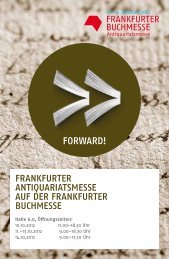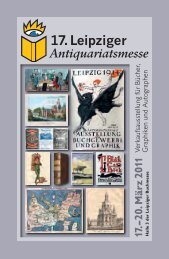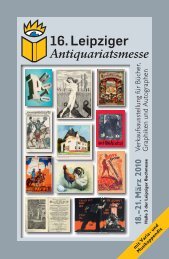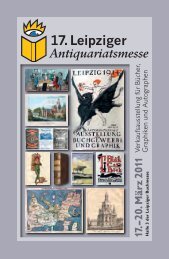18. Leipziger - abooks
18. Leipziger - abooks
18. Leipziger - abooks
Erfolgreiche ePaper selbst erstellen
Machen Sie aus Ihren PDF Publikationen ein blätterbares Flipbook mit unserer einzigartigen Google optimierten e-Paper Software.
88<br />
Stand 36<br />
ANTIQUARIAT MICHAEL KÜHN<br />
Erdmannstraße11•D–10827 Berlin<br />
Telefon (030) 86 39 69 34 • Fax (030) 86 39 69 55<br />
e-mail: kuehn.rarebooks@arcor.de • www.kuehn-booksde<br />
Naturwissenschaften • Technik • Medizin<br />
Boscovich, Roger Joseph. Abhandlung von den verbesserten Dioptrischen Fernröhren,<br />
aus den Sammlungen des Instituts zu Bologna; sammt einem Anhange des Uebersetzers<br />
C[arl]. S[cherffer]. S[ocietatis]. J[esu]. [= De lentibus et telescopiis dioptricis dissertatio;<br />
dt.] Wien, Trattner, 1765 8°. 183 S. Mit 2 mehrf. gefalt. Kupfertafeln. Halblederbd. späterer<br />
Zeit mit Rückenschild. Einige S. leicht gebräunt. Sauber und frisch. 1.200,-<br />
Erste deutsche Ausgabe, nach der Originalausgabe von 1755. Karl Scherffer’s Anhang enthält u. a. auch Auszüge<br />
aus Briefen Boscovichs.- Honeyman 426: “A translation with considerable additions by the translator”. very rare<br />
first german edition. First published in Rome 1755 it is a tract on the construction of lenses for telescopes, with<br />
instructions how to manufacture dioptric instruments with the use of two different lenses. Boscovich was a skilled<br />
experimentalist beyond being an accomplished mathematician. His aim in this work was providing guidelines for<br />
establishing the optimal refraction of lenses when viewing celestial bodies. He discusses the use of a new model of<br />
micrometer recently invented by Dollond in different sorts of telescopes, demonstrates the impossibility to reach a<br />
significant improvement of the magnification by use of a catoptric telescope with one lens. Ruggero Boscovich<br />
(1711-1787) is renowned as the author of the “Philosophiae naturalis theoria”. The translator Carl Scherffer (1716-<br />
1783), a Jesuit, supervisor of the Observatory at Graz, later Prof. of Mathematics in Vienna, introduced Newton’s<br />
Principia at the University of Vienna.- Holzmann-B. I, 7345. Pogg. II, 791 [unter Scherffer]; de Backer-S. I,<br />
1838, 55; Giese 673; Whyte 218; DSB II, 326-332; Roberts/Trent 45; Riccardi I/I, 178,45 [ital. ed.]. Zarko Dadic.<br />
The role of the Karl Scherffer in the acceptance and promotion of Boskovic’s scientific ideas; in: Proceedings of<br />
the International Symposium on Ruder Boskovic, Dubrovnik, 5th-7th Oct., 1987.- Zagreb, 1991. pp. 153-160.-<br />
KVK: Freiberg, Göttingen, Rostock, Jena, Hamburg, Erfurt, Weimar Anna Amalia [Verlust ?].<br />
Grass, Günter. Ausgefragt. Gedichte und Zeichnungen. Neuwied und Berlin, H. Luchterhand,<br />
1967. 8°. 124 pp., 6 Bl. Mit 15 (incl. Umschlag; davon 2 doppelblattgr.) Abb. nach Zeichnungen<br />
von G. Grass. Illustr. OBrosch., Rücken und Ränder des Rückdeckels gebräunt. 300,-<br />
Wilpert-G.2 20 (mit der Anmerkung „wurde nicht ausgeliefert“). Das seltenste Buch von Grass. Diese erste<br />
Aus-gabe des Gedichtbandes wurde von Günter Bruno Fuchs gestaltet, er wählte die Typographie und entwarf<br />
den Umschlag. Auch der Laie kann erkennen, daß das Produkt mißriet: Das Papier ist von minderer Qualität, der<br />
Abdruck der Zeichnungen ist flau, einige sind über zwei Seiten gedruckt, so dass sie ihre Wirkung völlig verfehlen,<br />
eine Faust zum Beispiel verschwindet dadurch im Falz. Der Umschlag zeigt eine undefinierbare Gemüsehöhlenlandschaft.<br />
Grass war von Fuchs’ Ergebnis erzürnt, die gesamte sogenannte „Januar“-Auflage wurde eingestampft.<br />
Im April erschien unter anderer Federführung eine revidierte Ausgabe, die Druckerei wurde gewechselt,<br />
Grass veränderte die Reihenfolge der Texte und ließ einige Zeichnungen unter den Tisch fallen. Das Gedicht<br />
„Ausgefragt“ blieb allerdings an erster Stelle: „Nach großem und nach kleingemünztem Zorn,“ so lautet<br />
dessen erste Zeile. Und die vorletzte: „Ist es jetzt besser? Es sieht besser aus.“ Im übertragenen Sinn trifft dies<br />
auch auf die Geschichte dieser Veröffentlichung zu. Frisches Exemplar, das der Papierpresse unbeschadet entkommen<br />
konnte.<br />
Guarini, [Camillo] Guarino. Modo di misurare le fabriche di D. Guarino Guarini ... in<br />
cui non vi e corpo, e quasi non vi e superficie, purche godi di qualche regolarita, che<br />
matematicamente non resti misurato, riducendosi a calcoli facilissimi anche quei piani, e<br />
quei corpi, di cui sin hora non e stato dato modo, che li misuri. Torino, per gli Heredi<br />
Gianelli, 1674. 8° [190 x 110 mm] 208 pp. with many woodcut diagrams within text.<br />
Pergamentbd. d. Zt., neu aufgebunden, neue Vorsätze, ordentl. Exemplar. 1.600,-<br />
Rare first edition. A handbook on the mensuration of buildings; the author stresses that architecture is based on mathematics.<br />
It included an adaptation of Euclid to learner of architecture with woodcut illustrations. Guarini (1624-1683), italian<br />
architect, mathematician, astronomer, theorist, writer and priest, is the most renowned exponent – together with<br />
Francesco Borromini – of the anti-classical, anti- vitruvian trend that dominated italian architecture after Michelangelo<br />
but increasingly lost ground from the late 17th century. Being a professor of mathematics, Guarini was almost unavoidably<br />
obliged to consider Euclidean geometry. His Euclidean interests probably arose during his early teaching of Mathematics<br />
at Messina where distinguished Euclidean scholars such as Francesco Maurolico and his pupil Giovanni Alfonso<br />
Borelli had taught previously. There Guarini found himself in one of the most stimulating scientific centers of the time<br />
where a long-standing Euclidean tradition existed. Maurolico wrote a commentary of the Elements, while Borelli was author<br />
of the Euclides Restitutus. Yet it was more likely in Paris, where Guarini taught mathematics between 1662 and<br />
1666, that his concern with Euclidean geometry expanded. For there he encountered a lively scientific milieu and particularly<br />
Francois Millet de Chales. A most distinguished mathematician, this latter was the author of Cursus seu mundu<br />
mathematicus, an encyclopedic work on mathematics that also dealt with architecture. Guarini was deeply influenced by<br />
Millet; he is referred to frequently in Guarini’s books, not just for geometrical or mathematical matters. Out of this back-









